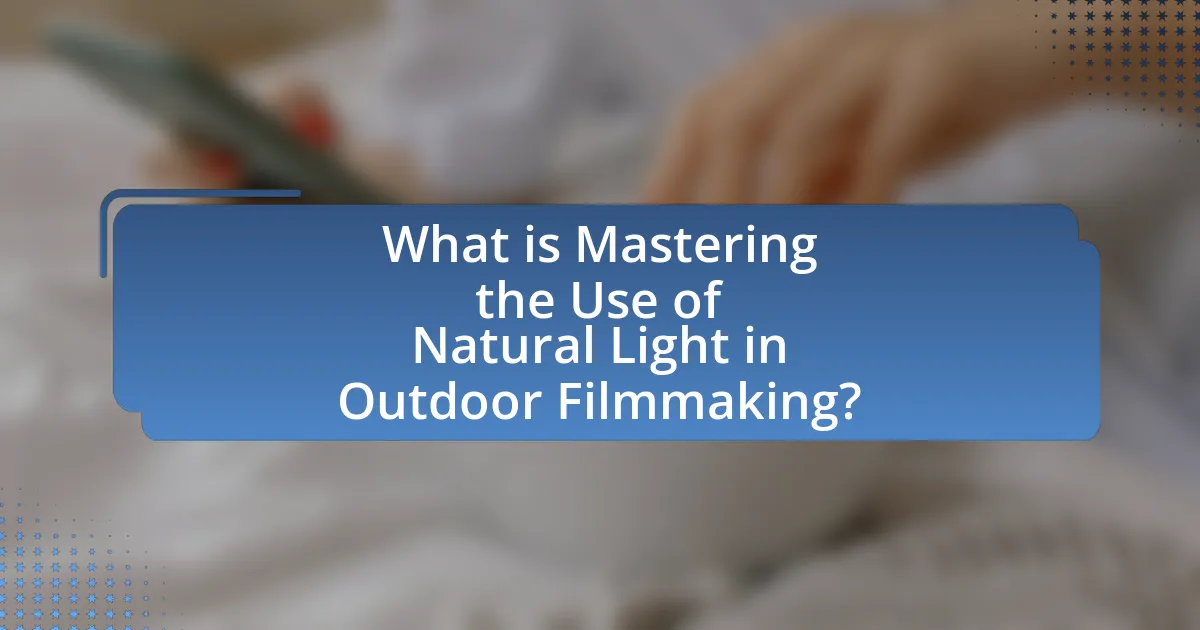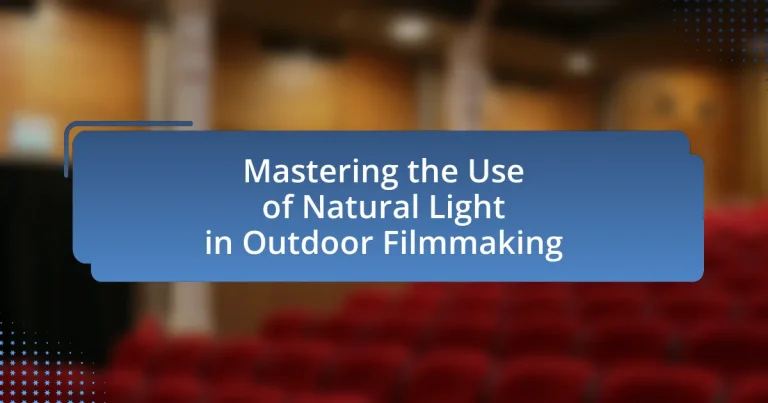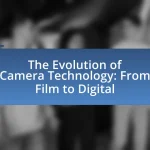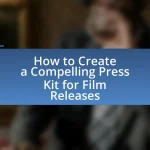Mastering the use of natural light in outdoor filmmaking is essential for enhancing visual quality and emotional impact. This article explores how natural light influences filmmaking, detailing its qualities such as intensity, color temperature, and direction, as well as the significance of timing, particularly during the golden hour. It also discusses techniques for effectively utilizing natural light, the advantages it offers over artificial lighting, and strategies for overcoming challenges posed by changing weather conditions. Additionally, practical tips for planning shoots and adjusting camera settings to optimize natural light usage are provided, ensuring filmmakers can achieve professional results in their projects.

What is Mastering the Use of Natural Light in Outdoor Filmmaking?
Mastering the use of natural light in outdoor filmmaking involves effectively utilizing sunlight and ambient light to enhance the visual quality of film projects. This technique requires an understanding of how natural light interacts with subjects, landscapes, and the time of day, allowing filmmakers to create mood, depth, and realism in their shots. For instance, the golden hour, which occurs shortly after sunrise and before sunset, provides soft, diffused lighting that is often preferred for its flattering qualities. By strategically planning shoots around these natural light conditions, filmmakers can achieve professional-looking results without the need for extensive artificial lighting setups.
How does natural light influence outdoor filmmaking?
Natural light significantly influences outdoor filmmaking by affecting the visual quality, mood, and overall aesthetic of the footage. The direction, intensity, and color temperature of natural light can create dramatic effects, enhance textures, and influence the emotional tone of a scene. For instance, the golden hour, which occurs shortly after sunrise and before sunset, provides soft, diffused light that is often preferred for its flattering qualities. Studies have shown that filmmakers who effectively utilize natural light can achieve a more authentic and immersive experience for viewers, as natural light tends to resonate with audiences on a subconscious level, enhancing the believability of the narrative.
What are the different qualities of natural light?
Natural light possesses several distinct qualities, including intensity, color temperature, direction, and diffusion. Intensity refers to the brightness of natural light, which varies throughout the day and affects the mood and visibility in outdoor filmmaking. Color temperature indicates the warmth or coolness of the light, measured in Kelvin; for example, sunlight at noon is around 5500K, providing a neutral tone, while sunrise and sunset produce warmer tones around 3000K. Direction describes the angle from which light hits the subject, influencing shadows and highlights; for instance, low-angle light during golden hour creates long shadows and enhances textures. Diffusion relates to how light spreads and softens; overcast skies diffuse sunlight, reducing harsh shadows and creating a more even illumination. These qualities are essential for filmmakers to manipulate and enhance the visual storytelling in outdoor settings.
How does the time of day affect natural light?
The time of day significantly affects natural light by altering its intensity, color temperature, and angle. During sunrise and sunset, known as the golden hour, light is softer and warmer, creating ideal conditions for outdoor filmmaking. In contrast, midday light is harsher and more direct, resulting in strong shadows and high contrast, which can be challenging for capturing details. Studies show that the angle of sunlight changes throughout the day, influencing how light interacts with subjects and landscapes, thus impacting the overall aesthetic of the footage.
Why is mastering natural light important for filmmakers?
Mastering natural light is crucial for filmmakers because it enhances the visual quality and emotional impact of their work. Natural light provides a dynamic range of colors and shadows that can create depth and realism in a scene. According to a study by the American Society of Cinematographers, films shot with natural light often achieve a more authentic look, which resonates better with audiences. Additionally, understanding how to manipulate natural light allows filmmakers to optimize shooting schedules and reduce reliance on artificial lighting, leading to cost-effective production.
What advantages does natural light offer over artificial lighting?
Natural light offers several advantages over artificial lighting, including enhanced color accuracy, improved mood, and energy efficiency. Natural light provides a broader spectrum of wavelengths, which results in more accurate color representation in outdoor filmmaking. Studies have shown that exposure to natural light can boost mood and productivity, making it beneficial for both filmmakers and subjects. Additionally, utilizing natural light reduces energy consumption, as it eliminates the need for artificial lighting sources, contributing to a more sustainable filmmaking process.
How can natural light enhance storytelling in film?
Natural light enhances storytelling in film by creating authentic atmospheres that resonate with viewers. The use of natural light allows filmmakers to capture the true essence of a scene, reflecting the emotional tone and setting more realistically. For instance, the golden hour, characterized by soft, warm light, can evoke feelings of nostalgia or tranquility, while harsh midday sunlight may convey tension or urgency. Studies have shown that natural lighting can significantly impact audience perception and emotional engagement, as it aligns closely with real-world experiences. This connection fosters a deeper immersion into the narrative, making the story more relatable and impactful.

What techniques can be used to effectively utilize natural light?
To effectively utilize natural light in outdoor filmmaking, filmmakers can employ techniques such as timing, positioning, and reflectors. Timing involves shooting during the golden hour, which occurs shortly after sunrise and before sunset, providing soft, diffused light that enhances visual quality. Positioning refers to the strategic placement of subjects in relation to the sun to minimize harsh shadows and maximize illumination. Reflectors can be used to bounce sunlight onto subjects, filling in shadows and creating a more balanced exposure. These techniques are supported by the fact that natural light varies in intensity and quality throughout the day, making careful planning essential for optimal results in outdoor settings.
How can filmmakers plan for natural light conditions?
Filmmakers can plan for natural light conditions by conducting thorough location scouting and utilizing tools like light meters and weather apps. Location scouting allows filmmakers to assess how natural light interacts with the environment at different times of day, which is crucial for determining optimal shooting times. Light meters help measure the intensity of light, ensuring that filmmakers can adjust their camera settings accordingly. Additionally, weather apps provide forecasts that inform filmmakers about potential changes in lighting conditions, such as cloud cover or sunset times, enabling them to adapt their shooting schedule effectively.
What tools can assist in predicting natural light availability?
Tools that can assist in predicting natural light availability include solar pathfinders, light meters, and smartphone applications designed for sunlight tracking. Solar pathfinders provide a visual representation of sunlight patterns throughout the day, helping filmmakers understand how light will change in a specific location. Light meters measure the intensity of light at a given moment, allowing for real-time adjustments during filming. Additionally, smartphone applications like Sun Surveyor and The Photographer’s Ephemeris offer detailed information on sun position and light availability based on geographic location and time, enhancing planning for outdoor shoots. These tools are essential for optimizing natural light use in outdoor filmmaking.
How can location scouting optimize natural light usage?
Location scouting can optimize natural light usage by identifying locations that maximize sunlight exposure at specific times of day. By analyzing the geographical orientation, surrounding structures, and natural features, filmmakers can select sites that enhance lighting conditions, such as open fields or areas with reflective surfaces. Studies show that shooting during the golden hour, which occurs shortly after sunrise and before sunset, provides the most flattering natural light, making location scouting essential for timing and positioning. Additionally, scouting allows filmmakers to anticipate weather patterns and seasonal changes, ensuring optimal light quality throughout the filming process.
What are the best practices for shooting with natural light?
The best practices for shooting with natural light include understanding the quality and direction of light, utilizing the golden hour, and managing exposure effectively. Photographers should assess the light’s softness or harshness, as soft light reduces shadows and enhances skin tones, while harsh light can create dramatic effects. Shooting during the golden hour, which occurs shortly after sunrise and before sunset, provides warm, diffused light that is ideal for capturing vibrant images. Additionally, using reflectors or diffusers can help manipulate natural light to achieve desired effects, while maintaining proper exposure settings ensures that images are neither overexposed nor underexposed, preserving detail and color accuracy.
How can filmmakers adjust camera settings for natural light?
Filmmakers can adjust camera settings for natural light by modifying the aperture, shutter speed, and ISO. A wider aperture (lower f-stop number) allows more light to enter the lens, which is beneficial in bright conditions, while a narrower aperture (higher f-stop number) can be used in lower light to maintain depth of field. The shutter speed should be set to double the frame rate for optimal motion capture; for example, if shooting at 24 frames per second, the shutter speed should be 1/50 second. Adjusting the ISO helps manage sensitivity to light; a lower ISO (e.g., 100) is ideal for bright conditions, while a higher ISO (e.g., 800 or 1600) can be used in dimmer settings, though it may introduce noise. These adjustments ensure proper exposure and image quality when utilizing natural light in outdoor filmmaking.
What composition techniques work best with natural light?
The composition techniques that work best with natural light include the use of leading lines, framing, and the rule of thirds. Leading lines guide the viewer’s eye towards the subject, enhancing depth and perspective, while framing utilizes natural elements to create a border around the subject, adding context and focus. The rule of thirds involves positioning the subject off-center, which often results in a more dynamic and engaging composition. These techniques are effective because they leverage the unique qualities of natural light, such as its ability to create shadows and highlights, which can enhance the visual interest of the scene.

What challenges do filmmakers face when using natural light?
Filmmakers face several challenges when using natural light, including unpredictable weather conditions, varying light intensity, and the need for precise timing. Unpredictable weather can alter lighting conditions rapidly, making it difficult to maintain continuity in shots. Varying light intensity throughout the day can create inconsistent exposure levels, requiring filmmakers to adapt their techniques or equipment frequently. Additionally, the timing of natural light, such as the golden hour, is limited, which can constrain shooting schedules and necessitate careful planning to capture the desired aesthetic. These challenges highlight the complexities of relying on natural light for outdoor filmmaking.
How can changing weather conditions impact outdoor shoots?
Changing weather conditions can significantly impact outdoor shoots by altering lighting, visibility, and the overall atmosphere. For instance, overcast skies diffuse sunlight, creating softer shadows and reducing harsh contrasts, which can enhance the quality of the footage. Conversely, direct sunlight can lead to overexposed highlights and deep shadows, complicating exposure settings. Additionally, rain or wind can affect equipment stability and safety, while changes in temperature can influence the performance of both crew and equipment. Historical data shows that filmmakers often adjust their shooting schedules based on weather forecasts to optimize lighting conditions, demonstrating the critical role weather plays in outdoor filmmaking.
What strategies can mitigate the effects of harsh sunlight?
To mitigate the effects of harsh sunlight in outdoor filmmaking, filmmakers can utilize several strategies. These include using reflectors to bounce light onto subjects, employing diffusion materials to soften direct sunlight, and scheduling shoots during golden hours—early morning or late afternoon—when sunlight is less intense. Research indicates that using diffusion can reduce harsh shadows and create a more flattering light quality, enhancing the overall visual appeal of the footage. Additionally, positioning subjects in shaded areas or using portable shade structures can effectively shield them from direct sunlight, further improving the filming conditions.
How can filmmakers adapt to unexpected lighting changes?
Filmmakers can adapt to unexpected lighting changes by utilizing adjustable lighting equipment and modifying camera settings. For instance, they can employ portable reflectors or diffusers to manipulate natural light, allowing for better control over shadows and highlights. Additionally, adjusting the camera’s ISO, aperture, and shutter speed can help compensate for sudden shifts in brightness. Studies show that filmmakers who are prepared with versatile gear and knowledge of exposure settings can effectively manage lighting variations, ensuring consistent image quality throughout their shoots.
What common mistakes should be avoided when using natural light?
Common mistakes to avoid when using natural light include shooting at the wrong time of day, failing to consider the direction of light, and neglecting to use reflectors or diffusers. Shooting during harsh midday sun can create unflattering shadows and overexposed highlights, while the golden hour provides softer, more flattering light. Additionally, not accounting for the light’s direction can lead to uneven lighting on subjects, diminishing the overall quality of the shot. Using reflectors can help bounce light onto subjects, while diffusers can soften harsh sunlight, enhancing the visual appeal of the footage.
How can overexposure be prevented in bright conditions?
Overexposure in bright conditions can be prevented by using neutral density (ND) filters, which reduce the amount of light entering the camera without affecting color balance. ND filters come in various strengths, allowing filmmakers to control exposure levels effectively, especially in direct sunlight. Additionally, adjusting the aperture to a smaller f-stop value can help limit light intake, while increasing shutter speed can also mitigate overexposure. These techniques are widely recognized in photography and filmmaking, as they enable optimal exposure settings even in challenging lighting conditions.
What are the pitfalls of relying solely on natural light?
Relying solely on natural light can lead to inconsistent lighting conditions, which may negatively impact the quality of outdoor filmmaking. Variability in weather, such as cloud cover or sudden changes in sunlight intensity, can create uneven lighting that affects the visual coherence of a scene. Additionally, the time of day influences the angle and quality of natural light, resulting in harsh shadows or overly bright highlights that can detract from the intended aesthetic. Furthermore, natural light may not provide sufficient illumination in low-light situations, limiting the ability to capture detailed images. These factors underscore the importance of having supplemental lighting options to ensure consistent and high-quality footage.
What practical tips can help filmmakers master natural light?
Filmmakers can master natural light by understanding the time of day, utilizing reflectors, and adjusting camera settings. Filmmakers should shoot during the golden hour, which occurs shortly after sunrise and before sunset, as this provides soft, diffused light that enhances the visual quality of scenes. Using reflectors can help bounce light onto subjects, filling in shadows and creating a more balanced exposure. Additionally, adjusting camera settings such as ISO, aperture, and shutter speed allows filmmakers to optimize their images based on the available light conditions, ensuring clarity and detail in their shots.
How can filmmakers create a lighting plan for outdoor shoots?
Filmmakers can create a lighting plan for outdoor shoots by assessing the natural light conditions at the shooting location and time of day. This involves analyzing the sun’s position, which changes throughout the day, to determine optimal lighting angles and shadows. For instance, the “golden hour,” shortly after sunrise or before sunset, provides soft, diffused light that enhances visual aesthetics. Additionally, filmmakers should consider using reflectors or diffusers to manipulate natural light, ensuring subjects are well-lit without harsh shadows. By planning for weather changes and utilizing tools like light meters, filmmakers can effectively adapt their lighting strategies to maintain consistent quality throughout the shoot.
What are the best times of day for shooting with natural light?
The best times of day for shooting with natural light are during the golden hour, which occurs shortly after sunrise and just before sunset. During these periods, the sunlight is softer and warmer, creating ideal conditions for photography and filmmaking. Research indicates that the angle of the sun during these times enhances the quality of light, resulting in more visually appealing images.


